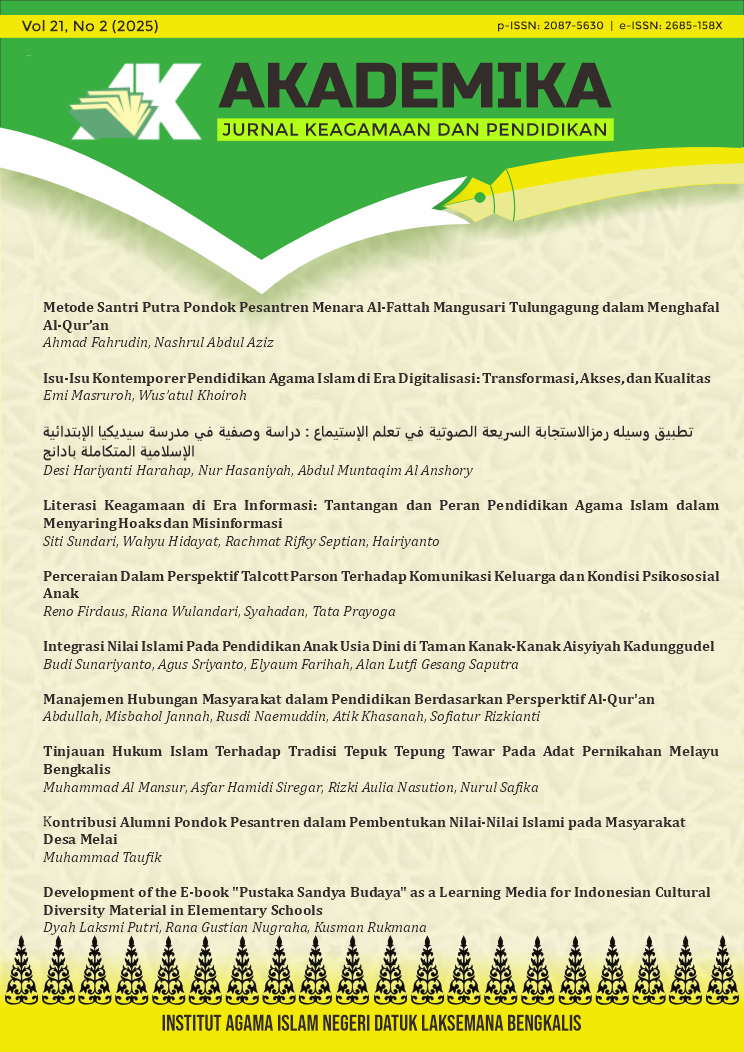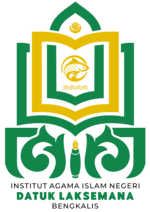Literasi Keagamaan di Era Informasi: Tantangan dan Peran Pendidikan Agama Islam dalam Menyaring Hoaks dan Misinformasi
DOI:
https://doi.org/10.56633/jkp.v21i1.1082Keywords:
Contemporary, Islamic education, Digitalization, transformationAbstract
The digital information era has brought a new dimension to the dissemination of knowledge, including religious information. Social media and online platforms have become the main channels for individuals to access and share religious content, but both also provide opportunities for the spread of fake news and misinformation, which have the potential to cause social unrest and distort understanding of religious teachings. This study aims to analyze the challenges of religious literacy in the context of the rise of digital information, especially related to the spread of fake news and misinformation related to religion among junior high school students in Central Bengkulu. Furthermore, this study examines the strategic role of Islamic Religious Education (PAI) subjects in developing critical and responsible religious literacy skills among students in the information era. Through a literature review and content analysis approach, this study identifies important religious literacy competencies, such as the ability to verify sources of information, a comprehensive understanding of the context of religious teachings, and increased awareness of the potential for information manipulation. In addition, this study explores how the PAI curriculum and learning methods can be adapted to equip students with the skills to filter information, identify fake news and religious misinformation, and promote peaceful and constructive religious narratives in the digital space. The findings of this study indicate that most students are exposed to too much unverified information, are vulnerable to the spread of fake news and misinformation, have limited digital literacy and critical thinking skills, and may be influenced by filter bubbles. On the other hand, although Islamic Religious Education (PAI) has not achieved optimal results, it has been proven to play an important role in developing students' ability to filter fake news and misinformation.
References
Aslan, R. (2010). No god but God: The origins, evolution, and future of Islam. Random House.
Baym, N. K. (2010). Personal connections in the digital age. Polity Press.
Berger, P. L. (2011). The many altars of modernity: Toward a paradigm for religion in a pluralist age. Walter de Gruyter.
Bruinessen, M. V. (2012). Traditions of learning and networks of ulama in Southeast Asia. Brill.
Buckingham, D. (2019). Media education literacy, learning and contemporary culture. John Wiley & Sons.
Castells, M. (2000). The rise of the network society. Blackwell Publishing.
Floridi, L. (2014). The fourth revolution: How the infosphere is reshaping human reality. Oxford University Press.
Jenkins, H., Purushotma, R., Weigel, M., Clinton, K., & Robison, A. J. (2009). Confronting the challenges of participatory culture: Media education for the 21st century. 1 MIT Press.
Kementerian Pendidikan dan Kebudayaan. (2013). Kurikulum 2013. Jakarta: Balitbang Kemendikbud.
Livingstone, S. (2004). Media literacy and the challenge of new information and communication technologies. The International Communication Gazette, 66(5), 491-506.
Noddings, N. (2010). Moral education in an age of globalization. Educational Philosophy and Theory, 42(4), 390-403.
Prothero, S. (2007). Religious literacy: What every American needs to know—and doesn't. HarperOne.
Sunstein, C. R. (2009). Republic. com 2.0. Princeton University Press.
Van Dijk, J. A. G. M. (2012). The network society. Sage.
Wardle, C., & Derakhshan, H. (2017). Information disorder: Toward an interdisciplinary framework for research and policy-making. Council of Europe.
Bruner, J. (1990). Acts of meaning. Harvard University Press.
Buckingham, D. (2019). Media education literacy, learning and contemporary culture. John Wiley & Sons.
Frau-Meigs, D., Flores, J. M., Pereira, F., Velez, I., & فاضلی, م. (2017). Digital media literacy in Europe: A comparative study. Routledge.
Hay, D., & Nye, R. (2006). The spirit of the child. Jessica Kingsley Publishers.
Jenkins, H., Purushotma, R., Weigel, M., Clinton, K., & Robison, A. J. (2009). Confronting the challenges of participatory culture: Media education for the 21st century. MIT Press.
Livingstone, S. (2004). Media literacy and the challenge of new information and communication technologies. The International Communication Gazette, 66(5), 491-506.
Lovat, T., & Toomey, R. (2009). Values education and quality teaching: The double helix effect. David Barlow Publishing.
Piaget, J. (1971). Genetic epistemology. Columbia University Press.
Prothero, S. (2007). Religious literacy: What every American needs to know—and doesn't. HarperOne.
Silk, M. (2014). Religion and public life: A conceptual guide. Columbia University Press.
Van Dijk, J. A. G. M. (2012). The network society. Sage.
Vosoughi, S., Roy, D., & Aral, S. (2018). The spread of true and false news online. Science, 359(6380), 1146-1151.
Vygotsky, L. S. (1978). Mind in society: The development of higher psychological processes. Harvard University Press.
Wardle, C., & Derakhshan, H. (2017). Information disorder: Toward an interdisciplinary framework for research and policy-making. Council of Europe.
Downloads
Published
Issue
Section
License
Copyright (c) 2025 Siti Sundari, Wahyu Hidayat, Rachmat Rifky Septian, Hairiyanto

This work is licensed under a Creative Commons Attribution-NonCommercial-ShareAlike 4.0 International License.
Authors who publish with this journal agree to the following terms:
- Authors retain copyright and grant the journal right of first publication with the work simultaneously licensed under a Creative Commons Attribution-ShareAlike 4.0 International License. that allows others to share the work with an acknowledgement of the work's authorship and initial publication in this journal.
- Authors are able to enter into separate, additional contractual arrangements for the non-exclusive distribution of the journal's published version of the work (e.g., post it to an institutional repository or publish it in a book), with an acknowledgement of its initial publication in this journal.
- Authors are permitted and encouraged to post their work online (e.g., in institutional repositories or on their website) prior to and during the submission process, as it can lead to productive exchanges, as well as earlier and greater citation of published work (See The Effect of Open Access).






